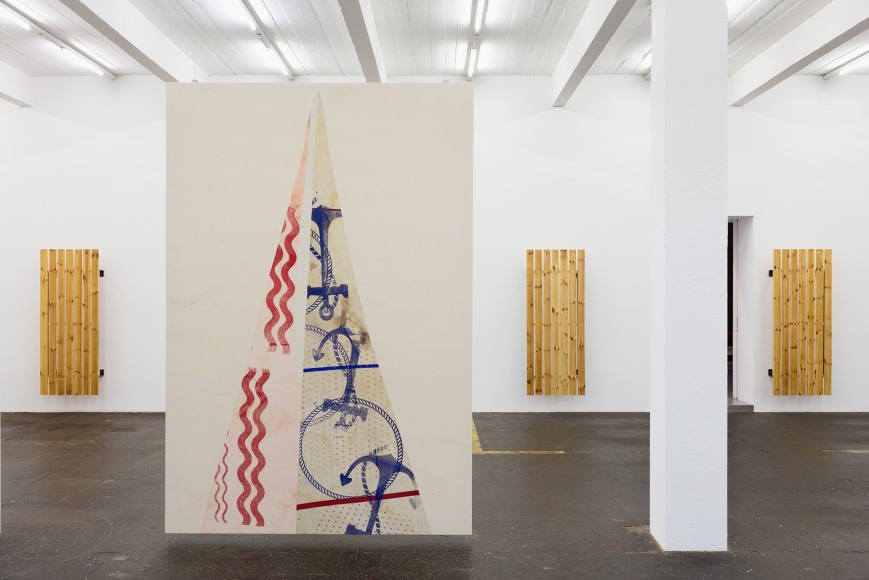The Norwegian artist Fredrik Værslev (*1979, lives and works in Drammen/NO and Vestfossen/NO) has made an impression through his extensive painterly practice, which despite precise planning and execution always leaves space for coincidence. For example, he exposes his works to the weather, hangs his canvases on display on trees for months, or offers artist colleagues his own works for interventions. He thus celebrates a defined painterly gesture and carries the idea of appropriation to extremes. At Kunst Halle Sankt Gallen Værslev surprises the visitors with an overall painterly installation which manifests itself between abstraction and the haptic reality of the materials used.
Two new work groups are being presented for the first time at Værslev’s exhibition «Tan Lines». The first includes canvases hanging in space, which face the second series of works on the wall as an installative whole. The monumental ‘Sail Paintings’ are assembled from variously worked pieces of canvas that have been brought together to produce a composition that is reminiscent of a boat’s sail. The series works as a complex hybrid: Værslev cuts up, combines, integrates and then minutely sews together earlier and newly created paintings. The procedure of deconstruction and reconstruction creates a connection to the fragmentary work process both visually and in terms of content. In doing so Værslev constantly eludes classification of the works, which might range from abstraction to decoration or representation. The ‘Sail Paintings’ create a landscape in Kunst Halle Sankt Gallen, which moves between seemingly realistic scenery and artistic fiction.
The symbolism depicted on the sails includes, among other things, certain codes which on the one hand point to a maritime environment and on the other to the artist’s immediate surroundings. The symbols act as much as signatures as gestures, and serve for contextualisation in that they leave traces of their environment on the surface. One will find the year of the artist’s birth as well as his initials, but also the international code for Norway and a modified version of the Kunst Halle Sankt Gallen logo.
The second work group presented at the exhibition is composed of ‘Garden Paintings’, on which Værslev has been working intensely in recent years. The wooden boards, mounted on metal frameworks and presented on the wall, oscillate between being minimalist painting and playful sculptural installation, and instinctively bring to mind a garden fence or benches protruding from the wall at eye level. The wooden slats have been repeatedly coated with both varnish and polish, and thus treated with the same restoration methods that are used for the maintenance of old wooden boats and of benches in classical museums. This almost performative, repetitive gesture culminates in a transparent layer that is saturated with liquid. Robbed of their original function and newly arranged on the wall, the slats transform from useful objects to surfaces glistening and reflecting with varnish. The exhibition space, viewers and ‘Sail Paintings’ are reflected and thus enter an intriguing dialogue.
«Tan Lines» will subsequently travel to Bonner Kunstverein (February 2018) and to Fondazione Giuliani in Rome (September 2018). An artist’s book will be published in spring by Sternberg Press and will accompany the exhibition tour.
(Source)








